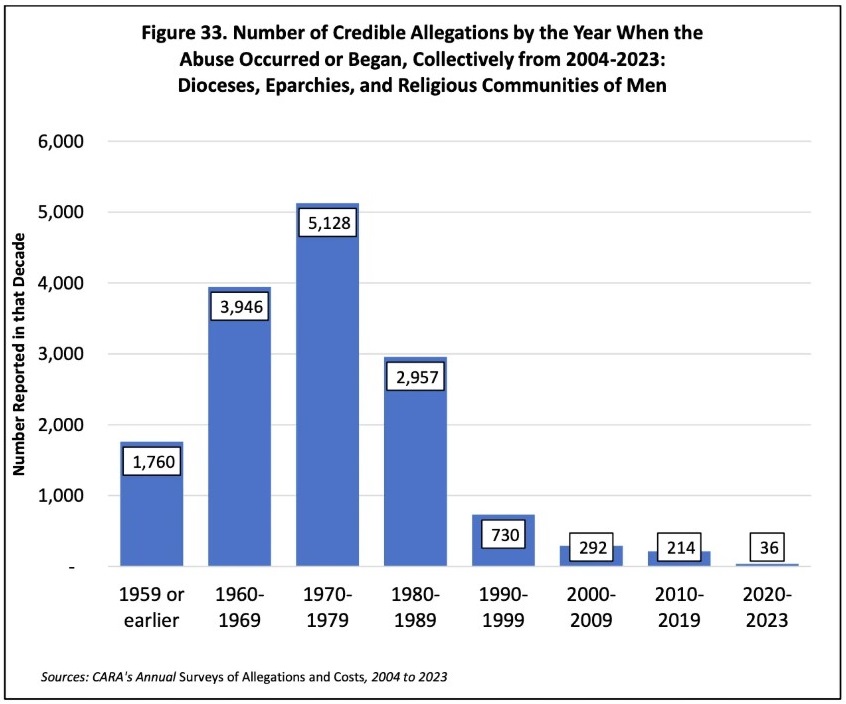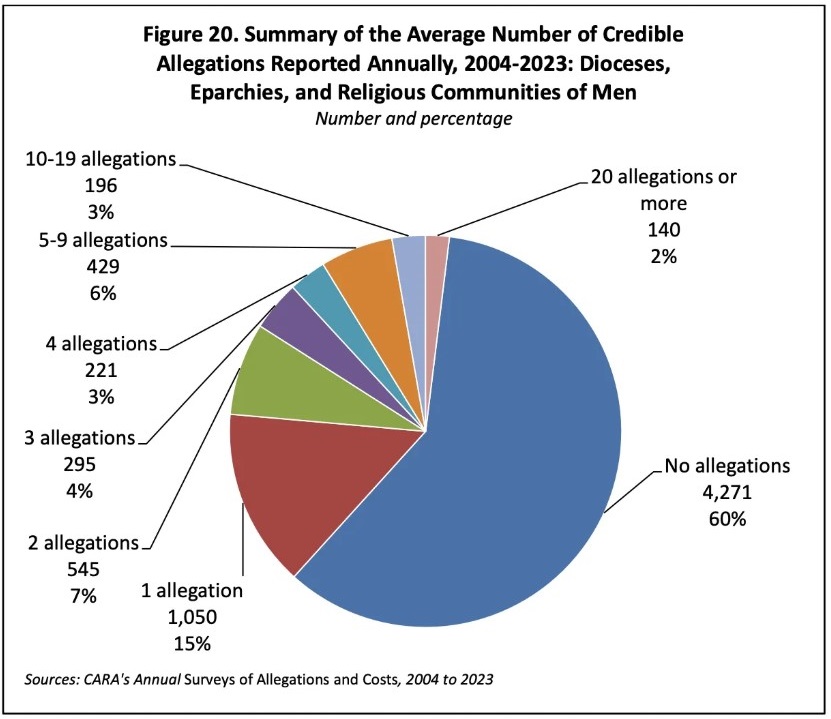WASHINGTON (DC)
The Pillar [Washington DC]
January 17, 2025
By Michelle La Rosa
[See also the full text of the CARA data summary report.]
Annual surveys from the past 20 years show a significant decline in credible allegations of child abuse by Catholic clergy members, according to data released this week.
But while experts say that might be a positive sign, they also acknowledge the report does not detail abuse of adults, and that allegations of abuse can sometimes take decades before they are reported.
The Center for Applied Research in the Apostolate at Georgetown University released Jan. 15 a report summarizing its findings from 20 years of surveys about child abuse allegations involving clergy in the United States.
The report found that the vast majority of credible allegations reported in the last two decades occurred in the 1980s or earlier.
Some 97% of credible allegations occurred before the year 2000.
In 2002, the Catholic Church in the U.S. adopted the Dallas Charter, a set of procedures to prevent abuse and address allegations.
The introduction of safe environment policies and background checks may be factors in the decline of abuse reports, said Deacon Bernard Nojadera, executive director of the USCCB’s Secretariat of Child and Youth Protection.
In addition, he told The Pillar, “increased awareness, ongoing education, and mindfulness of creating safe environments and safeguarding, and ongoing vigilance” have likely contributed.
But delays in reporting abuse could also be a factor, he acknowledged.
Dr. Jonathon Wiggins, the lead researcher on the CARA report, agreed.
“Abuse that might be going on right now, we might not hear about it for 20 years,” he said.
Wiggins told The Pillar that it is hard to pinpoint an exact cause for the decline in abuse allegations – particularly in the years leading up to the adoption of the Dallas charter and accompanying safe environment policies.
But overall, the awareness and environment today are different than they were in past decades, he continued.
“My sense really is that when I was growing up, my parents would’ve trusted me with the priest for anything. And it just seems like it’s a completely different environment now, and where people are aware of it,” he said. “I would guess that just awareness of that would have some effect.”
From a research perspective, Wiggins said, the changes undertaken by the Church in the past few decades are remarkable.
“I can’t think of any effort like this in any other non-governmental organization. To change it in 20 years, from basically not doing any background checks to it happening in all the dioceses and all the parishes – it really is quite an extraordinary turnaround and trying to reckon with the past,” he said.
Still, he acknowledged, the data reflected in the CARA survey is limited. It does not include allegations made against lay people – for example, a Catholic school teacher or principal.
Nor does it include allegations of clerical abuse against seminarians, spiritual directees, or other vulnerable adults.
“This is only about minors,” he clarified.

–
CARA’s annual surveys, commissioned by the U.S. Conference of Catholic Bishops, ask U.S. dioceses, eparchies, and male religious communities about child abuse allegations reported and prevention measures enacted each year.
On average, the survey has received a 99% response rate from dioceses and eparchies, and a 72% response rate from religious communities.
In any given year, three out of five survey respondents reported no allegations received.

“Over the 20 years of the survey, dioceses, eparchies, and religious communities have reported a grand total of 16,276 credible allegations of abuse of minors by priests, deacons, and religious brothers,” the report said.
Eighty-two percent of these allegations stemmed from dioceses or eparchies, and the other 18% came from male religious communities.
“Collectively over the 20 years of the annual surveys, an average of 59% of alleged perpetrators were identified by their dioceses, eparchies, and religious communities of men as having had prior allegations made against them,” CARA said.
The vast majority of alleged abuse perpetrators – six out of seven – were dead, already removed from ministry, laicized, or missing during the survey year. The remainder were “permanently removed from ministry or retired from ministry during the year” of that survey.
From 2004 to 2015, 82% of reported allegations were deemed “credible,” while 18% were deemed to be “unsubstantiated/obviously false.”
In 2016, an additional category of “unable to be proven” was added, for cases in which a preliminary investigation was not able to be completed – for example because alleged victims, perpetrators, or witnesses had died, or because the alleged victim had disengaged from the investigation process.
After the addition of this new category, 55% of reported allegations were deemed to be “credible,” while 31% were “unable to be proven,” and 14% were “unsubstantiated/obviously false.”
This change in credibility categorizations, along with the fact that religious brothers were not included in the survey until 2014, make it difficult to determine an exact number of alleged abuse perpetrators reported during the past 20 years.
The CARA report estimated the total number at 4,490 individuals, but cautioned that this number “should not be taken at face value.”
The data found that 80% of minor abuse victims were male, and 20% were female, in cases where the gender of the victim was known.
The majority of those victims — 54% — were between age 10 and 14 when they began to be abused. Another 24% of victims were between age 15 and 17 when the abuse began, and 20% were nine years old or younger.
Since 2004, U.S. dioceses, eparchies, and male religious communities have spent nearly $728 million on abuse prevention measures, including background checks, training programs, and salaries for safe environment and victim assistance personnel.
This amount has increased over time – with 80% more being spent on abuse prevention efforts in the most recent decade than in the previous one, according to the report.
During the past two decades, U.S. dioceses, eparchies, and male religious communities also reported spending $5 billion in costs related to abuse allegations. Most of that money — 75% — went to settlements and other payments to victims.

